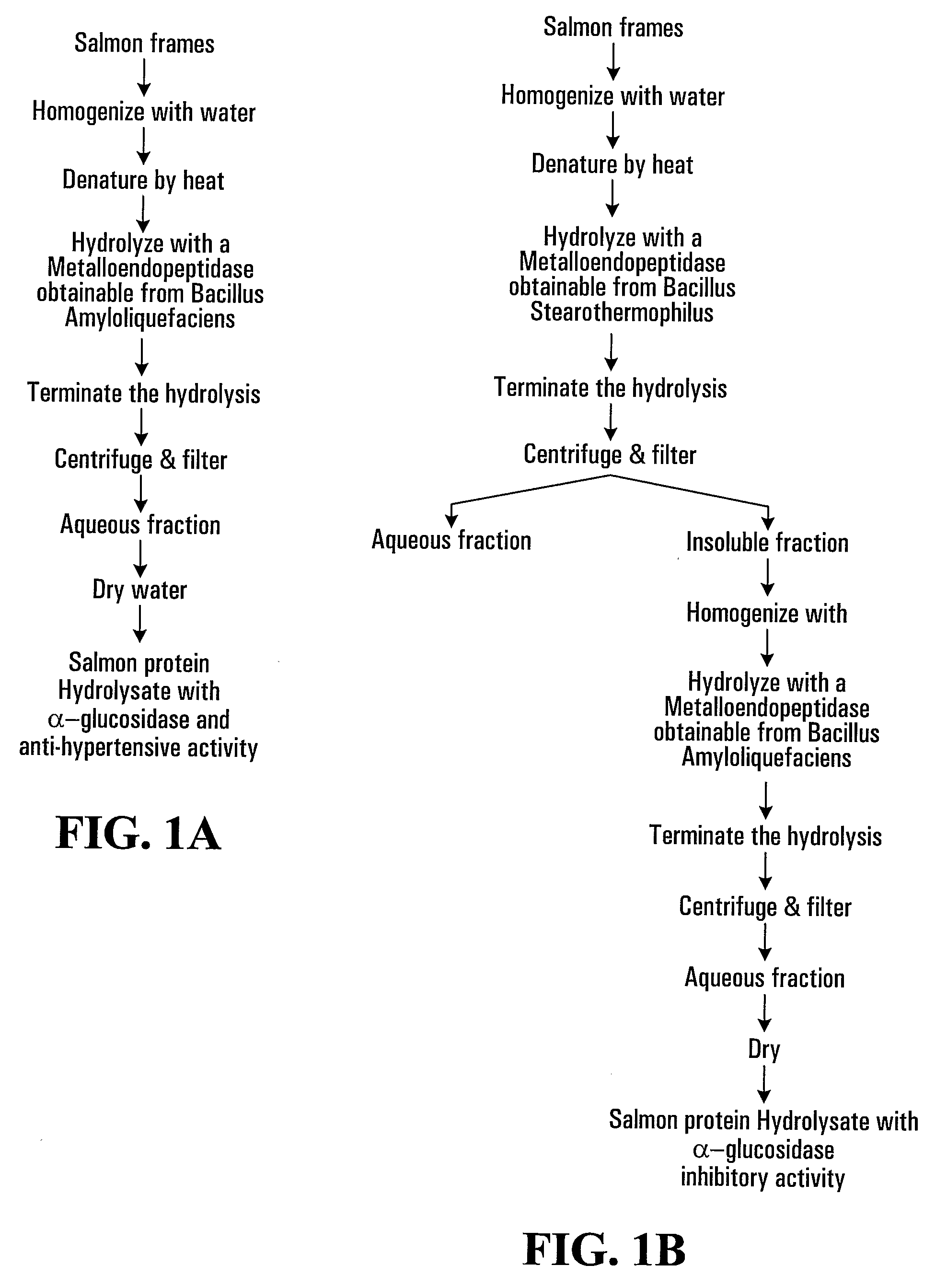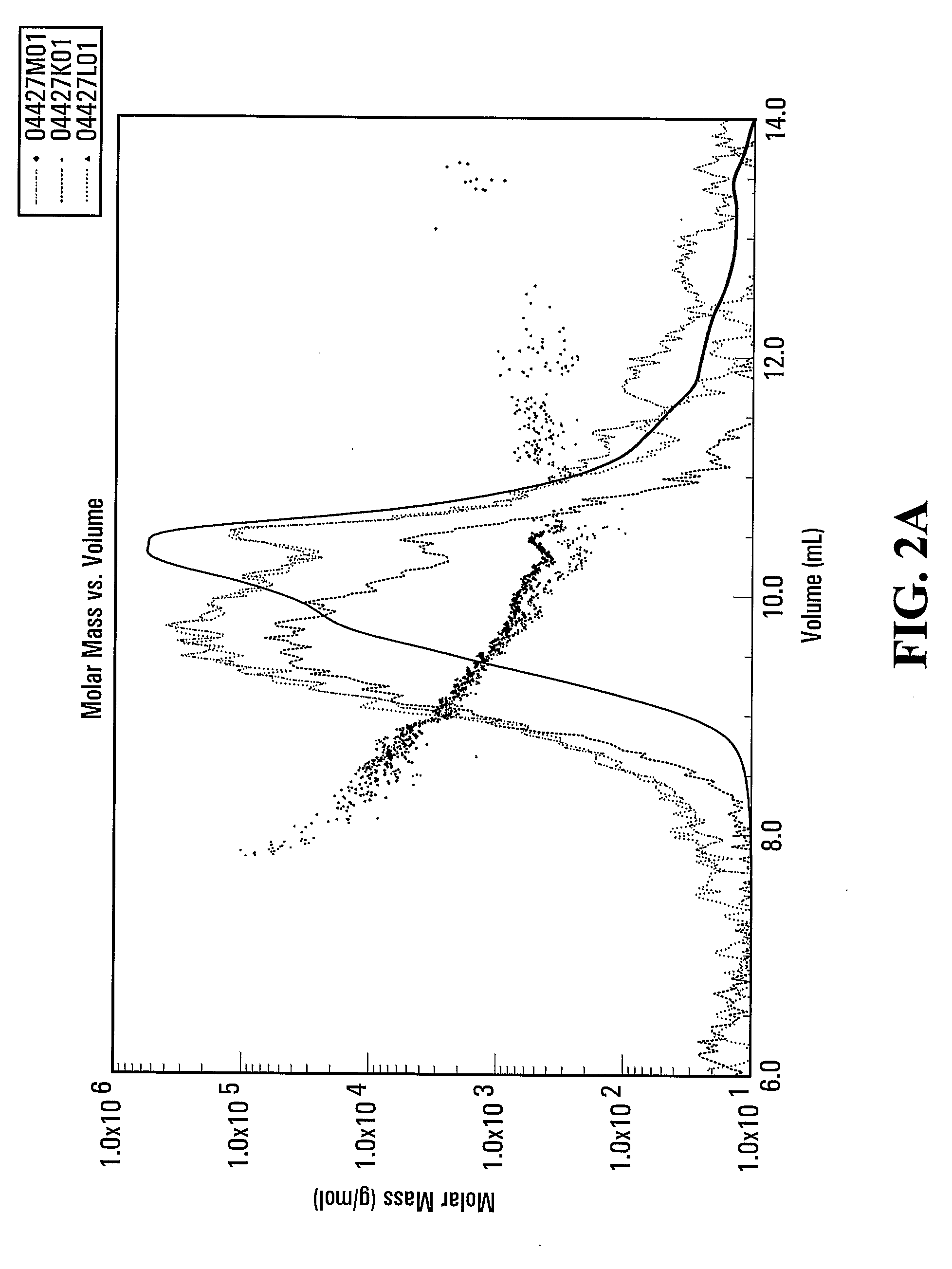Anti-Diabetic or Anti-Hypertensive Dietary Supplement
a technology of dietary supplement and anti-diabetic, applied in the direction of peptide/protein ingredients, metabolic disorders, cardiovascular disorders, etc., can solve the problems of limiting the use of dietary supplement, reducing the mean systolic blood pressure, and relatively inadequate insulin production
- Summary
- Abstract
- Description
- Claims
- Application Information
AI Technical Summary
Benefits of technology
Problems solved by technology
Method used
Image
Examples
example 1
[0093]This example describes the production of salmon protein hydrolysates by individual proteolytic enzymes and the α-glucosidase inhibitory activity of the hydrolysates.
[0094]Ground salmon racks were homogenized in water at a 1:1 ratio. 0.013% parabens was added to the homogenate to minimise bacterial degradation.
[0095]The homogenate was then heated to 70° C. for 10 minutes to denature the salmon protein. The homogenate was then cooled to 50° C.
[0096]The homogenate was hydrolysed using Protease M Amano, Protease S Amano, Proleather FGF or Multifect® Neutral and the in vitro α-glucosidase activity of the hydrolysates were measured.
[0097]As can be seen in table 1, the pH of the homogenate was adjusted to an optimum pH for each respective enzyme using 1N NaOH. Proteases were then added to aliquots of the homogenate in the enzyme / substrate (E / S) ratio specified for the respective enzyme in Table 1. Hydrolysis was performed for 5 hours at 50° C.
[0098]The pH was not maintained at a cons...
example 2
[0102]This example describes production of a salmon protein hydrolysate by digestion with Protease S Amano followed by Multifect® Neutral and the α-glucosidase inhibitory activity of the hydrolysate.
[0103]50 g of ground salmon frames were homogenized with 50 g of water. 0.013% parabens was added to the homogenate to minimise bacterial degradation.
[0104]The homogenate was heated to 70° C. for 10 minutes to denature the salmon protein. The homogenate was then cooled to 50° C. and the pH of the homogenate was adjusted to 8.0, the optimal pH of Protease S Amano, by the addition of 1N NaOH. Protease S Amano was added at a ratio of 2.6% w / w enzyme / substrate (protein in the salmon frames, as determined by the Kjeldahl method above). The hydrolysis reaction was carried out at 50° C. for 7 h. The pH was not maintained at a constant value. The mixture was heated to 85° C. for 10 minutes to terminate the hydrolysis reaction.
[0105]The resulting hydrolysate comprised an aqueous soluble phase and...
example 3
[0109]In this example the physiochemical properties of the salmon protein hydrolysate obtained by using Multifect® Neutral was analysed.
[0110]The degree of hydrolysis of the hydrolysate was assessed by the OPA method. The degree of hydrolysis was 29.9%.
[0111]The hydrolysate powder was dissolved in 88 mM sodium acetate and loaded on to a TSK G3000PWXL gel filtration column. The column was eluted with 88 mM sodium acetate at a flow rate of 0.75 ml / min. The elution was monitored by multi-angle light scattering (MALS) and RI detection. FIG. 2a and FIG. 2b show that 94.8% of the peptides within the salmon protein hydrolysate obtained with a digest using Multifect® Neutral are less than 2000 daltons.
PUM
| Property | Measurement | Unit |
|---|---|---|
| Temperature | aaaaa | aaaaa |
| Time | aaaaa | aaaaa |
| Inhibition | aaaaa | aaaaa |
Abstract
Description
Claims
Application Information
 Login to View More
Login to View More - R&D
- Intellectual Property
- Life Sciences
- Materials
- Tech Scout
- Unparalleled Data Quality
- Higher Quality Content
- 60% Fewer Hallucinations
Browse by: Latest US Patents, China's latest patents, Technical Efficacy Thesaurus, Application Domain, Technology Topic, Popular Technical Reports.
© 2025 PatSnap. All rights reserved.Legal|Privacy policy|Modern Slavery Act Transparency Statement|Sitemap|About US| Contact US: help@patsnap.com



